Conospermum incurvum, commonly known as plume smokebush, is a shrub endemic to Western Australia.

Hakea sericea, commonly known as bushy needlewood or silky hakea, is a large shrub with a profusion of mainly white flowers from July for several months. It is endemic to eastern Australia. It has become an environmental weed in some countries.

Isopogon sphaerocephalus, commonly known as drumstick isopogon or Lesueur isopogon, is a species of plant in the family Proteaceae and is endemic to the south-west of Western Australia. It is a shrub with linear to narrow egg-shaped leaves and spherical heads of hairy white to creamy yellow flowers.
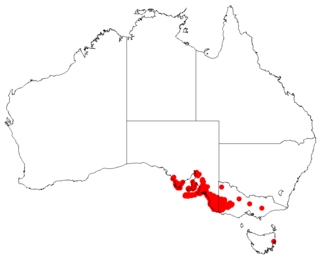
Hakea rugosa, commonly known as wrinkled hakea or dwarf hakea, is a shrub of the family Proteaceae native to Australia. It has sharp needle-shaped leaves and white or cream fragrant flowers in profusion from August to October.

Adenanthos barbiger, the hairy jugflower or hairy glandflower, is a species of shrub in the family Proteaceae. It is endemic to the south-west of Western Australia. It usually grows to 1 metre high, and has bright red flowers that appear mostly between August and December. The species was first formally described in 1839 by English botanist John Lindley in A sketch of the vegetation of the Swan River colony.

Hakea verrucosa is a shrub species in the family Proteaceae that is endemic to south-west Western Australia. It has large white, deep pink or red pendulous flowers with stiff needle-shaped leaves.
Persoonia pungens is a species of flowering plant in the family Proteaceae and is endemic to the south-west of Western Australia. It is an erect to spreading or low-lying shrub with densely hairy young branchlets, twisted elliptic to oblong, sharply-pointed leaves, and glabrous, bright yellow flowers borne in groups of up to five.

Hakea circumalata is a shrub in the family Proteaceae native to an area in the Wheatbelt and Mid West regions of Western Australia. A small shrub producing a profusion of strongly scented pink to red flowers in dense clusters from July to September.

Hakea cyclocarpa, commonly known as the ram's horn, wild bean or curved-fruit hakea is a shrub in the family Proteaceae. A strongly scented species with large creamy-white flowers with a red style and interesting fruit. Native to an area along the west coast and south west regions of Western Australia.
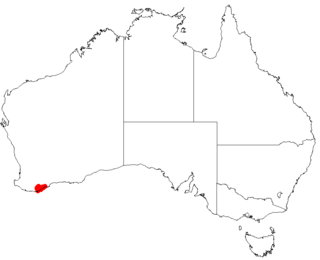
Hakea lasiocarpha, commonly known as long styled hakea, is a shrub in the family Proteacea and is endemic to Western Australia. It has about 30 whitish flowers in clusters in the upper leaf axils, rigid prickly leaves and a limited distribution.
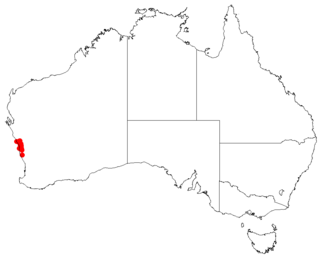
Hakea polyanthema is a shrub in the family Proteacea with small unpleasantly scented flowers in profusion in the leaf axils. It is endemic to Western Australia.
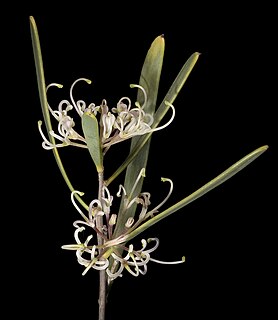
Hakea stenophylla is a shrub or tree in the family Proteacea, with sweetly scented creamy-white flowers. It is endemic to Western Australia.

Scaevola parvifolia is an erect, many stemmed perennial in the family Goodeniaceae, which is native to Western Australia, the Northern Territory, Queensland and South Australia. It grows to a height of 0.6 m, and its blue-purple flowers may be seen from March to October.
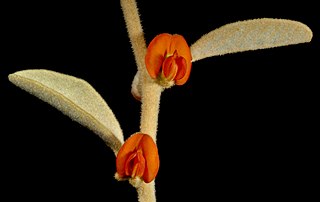
Tephrosia arenicola is a plant in the Fabaceae family, native to the north of Western Australia. The species has no synonyms.

Harpullia alata, common name -winged tulip or wing-leaved tulip, is a tree in the family Sapindaceae, endemic to eastern Australia, and found from Brisbane, Queensland to Grafton, New South Wales.

Dampiera candicans is a plant in the family Goodeniaceae, native to Western Australia and the Northern Territory.

Dampiera dentata is a plant in the family Goodeniaceae, native to Western Australia and the Northern Territory.

Caesia micrantha is a species of flowering plant in the family Hemerocallidaceae native to Western Australia.

Dicrastylis verticillata is a species of plant within the genus, Dicrastylis, in the family Lamiaceae. It is found in both South Australia and New South Wales.

Conostephium minus, common name pink-tipped pearl flower, is a shrub in the Ericaceae family, endemic to Western Australia.



















